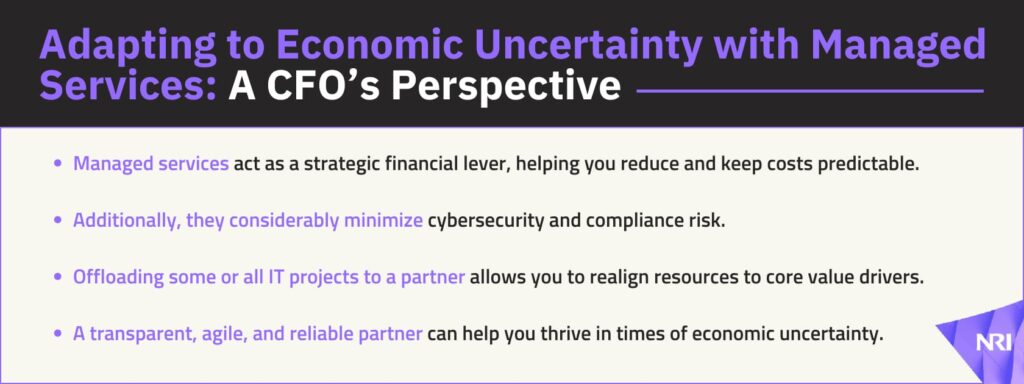Discover how leveraging MSP expertise can help control IT costs without compromises.

In January, Gartner projected that global IT spending will reach $5.61 trillion in 2025, representing a 9.8% year-over-year increase. However, in real terms, this increase may not be as impactful without a proactive budgeting strategy in place.
For example, the International Monetary Fund (IMF) forecasts global annual inflation will rise by 4.5% in 2025. This alone will absorb nearly half the real increase in global IT spending.
Meanwhile, there’s an acute labor shortage for niche (yet necessary) skills. According to CIO, 27% and 20% of organizations face challenges filling artificial intelligence (AI) and data science roles, respectively. Similarly, companies also struggle to find people to manage cybersecurity and compliance. Supply and demand economics dictate that this dynamic translates to higher salaries, further offsetting organizations’ real IT spending. By 2026, the skills gap is expected to cost organizations up to $5.5 trillion in revenue loss, quality issues, and delays, according to the International Data Corporation (IDC).
Market volatility, driven mainly by geopolitical tensions and shifting trade policies, has also created additional complexity in how organizations allocate resources.
As a CFO, your responsibilities have expanded from merely focusing on capital structure and financial statements to overseeing performance, operations, and strategy. You’re increasingly at the center of technology decisions, ensuring every dollar delivers measurable value and aligns with long-term business objectives.
All this brings us to one question. How can you strike a balance between cost control and the need for digital continuity and innovation amid economic uncertainty?
One strategy is to leverage managed services. Here’s all you need to know.
Managed Services as a Strategic Financial Lever
When managing IT in-house, organizations typically have significant fixed infrastructure investments. This includes the money expended on setting up and managing data centers, servers, networking hardware, and the facilities that host them.
One of the drawbacks of fixed infrastructure is that it restricts flexibility during different economic cycles.
For example, to capitalize on opportunities during an upturn, your organization may need additional investments in its fixed infrastructure. This isn’t cheap. The bigger challenge, however, is that a downturn leaves you with more capacity than required, thereby robbing you of the opportunity to save on costs.
The same reasoning applies when maintaining a fully-fledged in-house team. When expansion requires additional headcount, more dollars in your budget go to hiring, training, and upskilling. And yet you can’t simply let go of some employees when there’s a downturn, as it would be challenging to refill those roles.
That’s where managed services come in. These services allow you to leverage an external resource to manage some or all of your IT functions. Your managed services provider (MSP) provides the required infrastructure and expertise for a fixed monthly fee, allowing you to reduce your capital expenditures and make operating expenses more predictable. Whenever requirements change, you simply engage with them to reduce or scale up capabilities. As a result, you can maintain your agility without overinvesting in IT or taking on too much risk.
The Risk Reduction Advantage
Organizations now incur $9,000 per minute of downtime and $4.88 million whenever there’s a data breach. Meanwhile, tech teams see some of the highest turnover rates. Managed services can help mitigate these risks.
MSPs are typically adept at optimizing the latest technologies for different scenarios. One example is deploying cutting-edge AI to continuously monitor for, identify, triage, and respond rapidly to constantly evolving cybersecurity threats in your unique environment. According to IBM’s 2024 Data Breach Report, such extensive use of security AI boosts prevention by 43% and response by 33%. Your MSP can similarly help you leverage AI to automate and optimize compliance reporting.
Another great benefit that adds to peace of mind when working with reliable managed services is business continuity and disaster recovery planning. Your MSP works with you to establish acceptable data loss and downtime thresholds and create contingencies, such as a multi-pronged backup strategy with reliable cloud backups to augment on-premises ones. This means business doesn’t come to a standstill if there’s an event like a ransomware attack.
Similarly, managed services reduce your exposure to staffing turnover and skills shortages, as your MSP is responsible for hiring, training, and retaining experts in all the specialized areas your business requires.
Realigning Resources to Core Value Drivers
Outsourcing IT gives you more bandwidth. As your MSP works to keep your IT environment modern and free from technical debt, your internal team can focus on meeting business requirements. Similarly, money saved can create space for strategic investments in growth initiatives, such as entering new markets.
What CFOs Should Look for in a Managed IT Services Partner
When choosing an MSP, it’s essential to recognize that not all providers will be a good fit for you. To make the right choice, we recommend seven areas of focus:
- Social proof. Do case studies and testimonials on the MSP’s website indicate that they possess relevant experience in your industry vertical? Are they accredited?
- Ability. Does the MSP specialize in the platforms you use in the existing environment? If not, can they effectively transition you to something new?
- Multi-faceted proficiency. Does the MSP have the will and chops to support technology that’s regularly used by your team, even if it isn’t the MSP’s core focus?
- Flexible pricing. Does the cost model accurately reflect changes in business capacity needs?
- Proactiveness. Does the MSP implement precautionary measures to prevent fires from breaking out? How do they manage unwanted incidents?
- Availability. Can the MSP support your team for as long as you need them to?
- Service level agreement (SLA). What are the exact responsibilities of the MSP? What metrics will you use to measure service quality, availability, and performance standards? Is there a sound framework for resolving disputes?
Get Started with Managed IT Services
When CFOs in leading organizations want to leverage proven managed IT services to navigate certain and uncertain economic times, they turn to NRI. For over 20 years, we have provided strategic IT advisory and implementation services to help numerous organizations reap the long-term financial benefits of an ultra-robust and secure environment tailored to their specific business needs. Our strong partnership with top technology vendors, including Microsoft, Cisco, Databricks, Pure Storage, and VMware, means you can count on us for the most innovative and connected technology solutions.
Ready to work with us? Schedule a complimentary, personalized consultation to explore your next steps.



